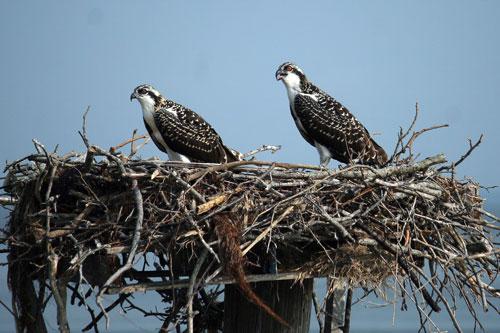Building a platform for an osprey nest in the Chesapeake watershed won’t turn you into a bird expert overnight but it is fun and you might learn a thing or two about yourself as well as these amazing raptors. Last year Mort Deckleman set up an Osprey pole for us safely beyond the end of our dock and about 20 feet above the water line. And with true beginners luck, two young ospreys, Orville and Amelia by name, soon spied my platform on their way back from South America and, after a brief courtship, quickly began building and decorating a proper nest.
I could not have been prouder and, within a few weeks, I began spreading the news and passing out virtual cigars to commemorate our new tenants and their blessed event. Now, while I have no regrets at naming our newly wed Osprey couple Orville and Amelia, we have been advised that it is not good form to name the chicks – at least not too early in the game.

In one of David Gessner’s great osprey books, Soaring with Fidel, he vividly describes a scene in which some folks installed a video camera and grew a little too attached to the young chicks. Not content with naming the parents, the video watching community also grew very attached to the chicks, whom we will call Fatso, Fluffy and Pipsqueeky. Apparently all went well while the fishing was good and there was plenty of food to go around.
Unfortunately, whenever food was scarce, the elder chicks, Fatso and Fluffy, elbowed (winged?) their way to the front of the line and poor little Pipsqueeky often went to bed hungry. Sometimes, we were told, the mama osprey would carry some leftover food over to her littlest one but this was rarely enough.
Ultimately after several days of this, little Pipsqueeky expired and his mama gently carried him out of the nest on one penultimate flight into a nearby tree.
Then, the watchful community hovered around their video screens to see what would become of the other chicks. Would food arrive in time? Would one of the parents catch at least some little fish or eel or even a frog and bring it back to their ravenous chicks?
At long last, here to the rescue came the mama osprey with some morsel clasped firmly in her claws. Straight she flew back to the nest and in full view of the video camera to share this bit of food with her darling chicks. But just as that morsel came within video range there went up a cry that could be heard throughout the town: “NOT SQUEEKY!!”
With this story in mind, as ‘foster’ parents of our nearby ospreys, we continue to monitor progress from our back porch but wait just a little longer before becoming too attached to this next generation of osprey tenants sharing our home.
You’ll be pleased to know that last year not only did the osprey parents work together to successfully raise their one chick but they then flew off in September on their annual migration to South America and both promptly returned on St. Patrick’s Day to once again take up residence on the nest above the river behind our home. The big difference is that this year they successfully raised not just one but three chicks and the fishing must have been good because within a span of just seven weeks all three chicks had grown to the size of their parents. Then, came the great adventure as first one chick and then the other clumsily began their flying lessons, alternately “helicoptering” a few inches above the nest while madly flapping their wings.
(NOTE: I’m using the term “chick” loosely here because these fledglings were gigantic although still unable to fly and still totally dependent on their parents for room and board.)
While watching these young fledglings it is difficult not to anthropomorphize as you imagine yourself perched on the edge of that nest looking down at the water below. “How can you possibly trust those around you who madly insist that you leap out into that great unknown? Isn’t there some kinder gentler way to get down?”
At the same time, as a parent myself, I can’t help but identify with the now obviously exhausted adult ospreys who have been desperately trying to feed three rapidly growing adolescents who, despite their enormous size, are no help at all. With so much work to do, you can easily see why it would require well matched monogamous parents to share all the chores of child care, fishing and nest building and maintenance.
Think of it for just a moment. Most humans can scarcely walk by the end of their first year and even a young calf needs to do nothing more challenging than learn to eat the green grass growing beneath its feet. But a young osprey needs to grow, learn to fly and catch fish and acquire all the skills needed to survive and navigate at least 3,000 miles (and back) all within the first 3 months’ of its life.
And yet, one by one the young fledgling ospreys did finally not only make that great leap but stretched their wings and made great soaring circles in the sky. Then, when their parents and I had almost given up hope, they also began slowly to earn their own keep, occasionally catching a fish and even bringing some home for dinner.
Sadly, in just a few short weeks they will all depart but I can’t wait til next St. Patrick’s day when Orville and Amelia come home again.
David Foster writes for the Spy from his perch overlooking the Chester River.



Barbara in den Bosch says
Delightful story, David. Thanks for lightening the afternoon.
Barbara